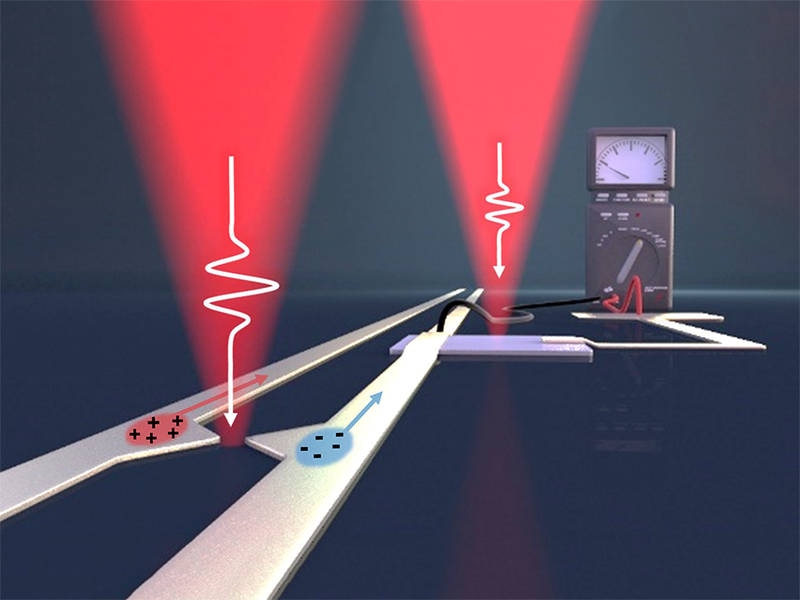Jun 27 2018
 Pulses of femtosecond length from the pump laser (left) generate on-chip electric pulses in the terahertz frequency range. With the right laser, the information is read out again. Image credit: Christoph Hohmann/NIM, Holleitner/TUM.
Pulses of femtosecond length from the pump laser (left) generate on-chip electric pulses in the terahertz frequency range. With the right laser, the information is read out again. Image credit: Christoph Hohmann/NIM, Holleitner/TUM.
For the first time, a group of researchers led by Alexander Holleitner and Reinhard Kienberger, TUM physicists, has been successful in producing ultrashort electric pulses on a chip with the help of metal antennas, with a size of only a few nanometers, and then passing the signals a few millimeters above the surface and reading them again in a controlled manner. The technology opens the door for the development of innovative, robust terahertz components.
Frequencies of up to 100 GHz are allowed by classical electronics. In the field of optoelectronics, electromagnetic phenomena starting at 10 THz are used. The range that falls in between is known as the terahertz gap because components for the generation, conversion, and detection of signals have been highly challenging to implement.
The TUM physicists Alexander Holleitner and Reinhard Kienberger were successful in producing electric pulses in the frequency range of up to 10 THz with the help of tiny, so-called plasmonic antennas and pass them over a chip. Researchers term antennas as plasmonic if, owing to their shape, they amplify the light intensity at the metal surfaces.
The shape of the antennas is crucial. They are asymmetrical; one side of the nanometer-sized metal structures is more pointed compared to the other side. Upon being excited by a lens-focused laser pulse, the antennas emit more electrons on their pointed side compared to the opposite flat sides. There is a flow of electric current between the contacts only as long as the antennas are excited using the laser light.
In photoemission, the light pulse causes electrons to be emitted from the metal into the vacuum. All the lighting effects are stronger on the sharp side, including the photoemission that we use to generate a small amount of current.”
Christoph Karnetzky, Lead Author
The structure is specifically intriguing since it is possible to integrate the nano-antennas into terahertz circuits with a size only a few millimeters.
Karnetzky stated that a femtosecond laser pulse with a frequency of 200 THz can produce an ultra-short terahertz signal with a frequency of nearly 10 THz in the circuits on the chip.
Sapphire was used as the chip material by the researchers since it could not be stimulated optically and, hence, does not lead to interference. Eyeing future applications, the researchers used 1.5-μm wavelength lasers deployed in conventional Internet fiber-optic cables.
Holleitner and his team chanced upon one more incredible discovery: They found that the terahertz pulses and the electrical pulses depended non-linearly on the excitation power of the laser used.
This shows that the photoemission in the antennas is activated by the absorption of multiple photons for each light pulse.
“Such fast, nonlinear on-chip pulses did not exist hitherto,” stated Alexander Holleitner. He hopes that this effect can be used to discover more rapid tunnel emission effects in the antennas, which can be used for chip applications.